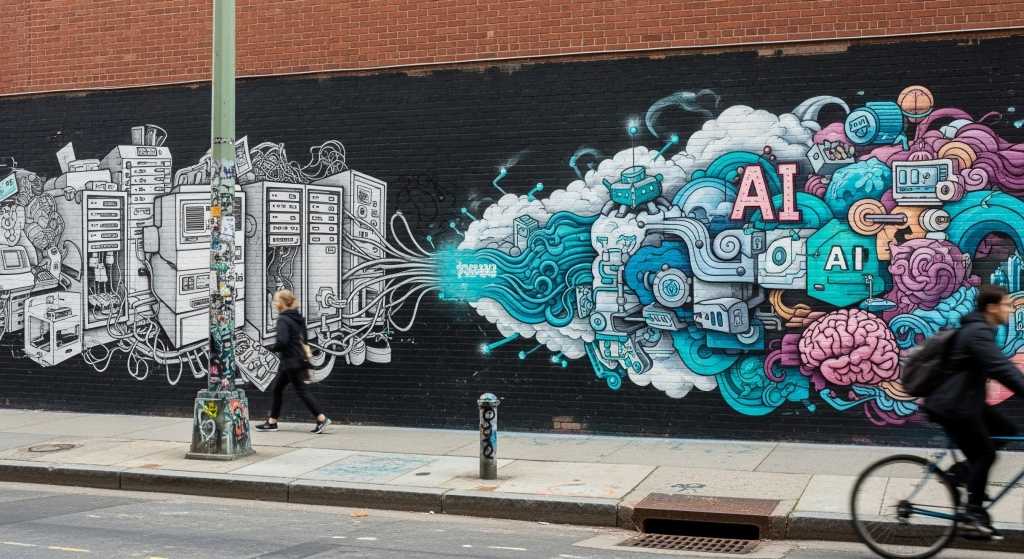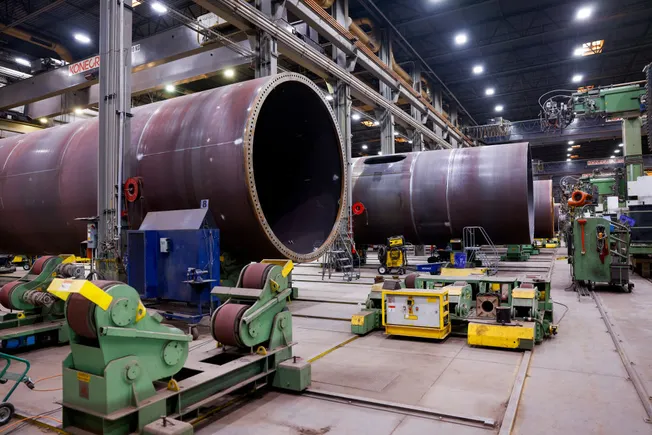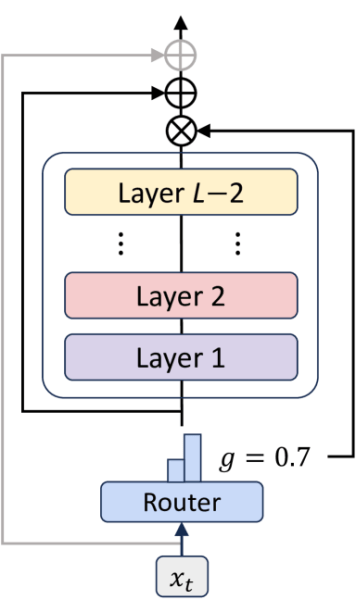
Jason Johnson, CIO, Sweetwater
Rani Johnson, CIO, Workday
Mike DiBenedetto, CIO, Northland Investment
John Kreul, CIO, Jewelers Mutual

Jason Johnson, CIO, Sweetwater Rani Johnson, CIO, Workday Mike DiBenedetto, CIO, Northland Investment John Kreul, CIO, Jewelers Mutual

Jason Johnson, CIO, Sweetwater
Rani Johnson, CIO, Workday
Mike DiBenedetto, CIO, Northland Investment
John Kreul, CIO, Jewelers Mutual
Stay ahead with more perspectives on cutting-edge power, infrastructure, energy, bitcoin and AI solutions. Explore these articles to uncover strategies and insights shaping the future of industries.

Global investment firm Blackstone announced it entered into an agreement to acquire a majority stake in network automation platform provider NetBrain Technologies. While financial details of the deal were not disclosed, Blackstone’s growth investment in NetBrain valued the technology provider at $750 million. “AI has the power to transform how

Jason Johnson, CIO, Sweetwater Rani Johnson, CIO, Workday Mike DiBenedetto, CIO, Northland Investment John Kreul, CIO, Jewelers Mutual

Moreover, they’re reporting that the executive drive for all things AI has them recalibrating their IT project agenda, prioritizing AI spending while bumping other items down or even off the to-do list. “Budgets are finite, and because AI investments are an imperative for CEOs, the boards, and CIOs to support

As a result, CIOs at most companies have a tougher time attracting machine learning engineers, prompt engineers, and other AI-specific talent, Goldberg says. That leaves many turning to AI consultants and training their existing data engineers, enterprise architects, and others so they can slide into those AI positions. “They’re assessing

Electric utilities will invest more than $1.1T by 2030 to meet demand growth: EEI | Utility Dive Skip to main content An article from The electric utility sector’s capital expenditures “are higher than any other sector in the U.S. economy,” Edison Electric Institute President and CEO Drew Maloney said. Published July 23, 2025 A composite wind blade. U.S. electric utilities brought 52 GW of total new generating capacity online in 2024, 11% more than in 2023 and 48% more than in 2022, according to a July 23, 2025, report from the Edison Electric Institute. Scott Olson via Getty Images Investor-owned U.S. electric utilities will invest more than $1.1 trillion in the 2025-2029 period, marking a rapid increase in capital expenditures as the sector rushes to meet growing power demand, according to a Wednesday report from the Edison Electric Institute. Capital expenditures from 2015 to 2024 totaled $1.3 trillion, the trade group noted. Permission granted by Edison Electric Institute The electric utility sector’s capital expenditures “are higher than any other sector in the U.S. economy, outpacing transportation, retail, and other capital-intensive industries,” EEI President and CEO Drew Maloney said in a statement. “As demand for electricity continues to grow, we remain committed to making the investments needed to strengthen America’s energy security while ensuring that our customers receive reliable, affordable energy.” Much of the investment is going to meet rising demand from data centers. While predictions for AI-related load growth vary, EEI’s financial review cited a McKinsey study predicting data center demand will rise about 20% annually from 2023 to 2030, from 60 GW today to 170-220 GW. Depending on factors, demand could even reach 300 GW, the McKinsey analysis said. But not all proposed data centers will ultimately be built, experts agree. A Schneider Electric 2030 AI power demand estimate put scenario ranges

The Federal Energy Regulatory Commission on Monday approved fast-track interconnection processes proposed by the Midcontinent Independent System Operator and the Southwest Power Pool. The two temporary processes, which are similar, aim to bring power supplies online quickly to meet near-term grid needs. In SPP, utilities and other “load responsible entities,” or LREs, will select potential projects for fast-track interconnection reviews. State utility commissions or other “relevant electric retail regulatory authorities,” or RERRA, would vet potential projects for being considered in MISO’s review process. Generally, state utility regulators supported the proposals. They were opposed by renewable energy companies and public interest groups which argued, in part, that they violated FERC’s principle of providing nondiscriminatory access to the grid. In its decisions on MISO’s Expedited Resource Addition Study process and SPP’s Expedited Resource Adequacy Study process, FERC rejected arguments that the plans violated the agency’s open access principles and that they discriminated against certain types of resources. FERC said, for example, that SPP’s proposal was resource, ownership and technology neutral, and applied the same eligibility criteria across all potential interconnection requests. “In this way, we find that SPP’s proposal ensures that all interconnection customers will have comparable ability to seek to participate in the ERAS process,” FERC said. The approved processes will allow planned resources that meet eligibility criteria to sidestep MISO’s and SPP’s standard interconnection queue reviews. Gas-fired power plants will likely be the main beneficiary of the fast-track processes, with standalone batteries also potentially being included in the fast-track reviews, according to ClearView Energy Partners. However, depending on the energy policy preferences of utility regulators and LREs, the fast-track processes could result in the selection of some renewable resources, particularly projects with onsite battery storage. ClearView, a research firm, said Tuesday. In May, the PJM Interconnection selected about 11.8 GW

Anna Shpitsberg is principal of WattsNext Advisory and former chief climate officer at the Development Finance Corporation. Previously, she served as deputy assistant secretary of energy transformation at the U.S. Department of State. On July 4th, the budget reconciliation bill was signed into law, reversing course on a historic expansion of energy and manufacturing production in the U.S. The consequences won’t just impact corporations — every consumer will feel the sting. The impact will ripple through the economy. Developers, in particular, need to move from concern to action, expediting their procurement processes and locking in key milestones to qualify for expiring credits. The pressure mounted not only with the bill’s passage, but with the July 7th executive order “Ending Market Distorting Subsidies for Unreliable Foreign Controlled Energy Sources.” The order instructs the Department of the Treasury and the Internal Revenue Service to issue tighter guidance on safe harbor provisions by Aug. 18, adding uncertainty to what qualifies as the “start of construction” and thereby eligible for clean energy tax credits. The reconciliation bill and executive order: accelerate credit phaseouts of technologies driving today’s growth in power capacity, with no exclusions for delays beyond control; impose new conditions on foreign ownership, without accounting for supply chain integration; and constrain credits for clean energy component manufacturing that spurred industrialization and job creation. The combined impact is a recipe for economic drag and reverse growth, impacting jobs, electricity prices, investment and power supply. The estimates are sobering. Energy Innovation projects 760,000 job losses by 2030, while a revised Center for Climate and Energy Solutions analysis projects over 2 million jobs could be lost over 10 years, with a $419 billion hit to GDP. This doesn’t stop at the paycheck — it spills over to expenses. According to several studies, including the American Clean

Baker Hughes Co. on Tuesday reported $623 million in adjusted net income for the second quarter, up 22 percent quarter-on-quarter and 10 percent year-on-year thanks to improved productivity. Its adjusted earnings per share of $0.63, assuming dilution, beat the Zacks Consensus Estimate of $0.55. Baker Hughes declared a dividend of $0.23 per share for Q2 2025. Before adjustment for nonrecurring items, net profit came at $701 million, up 74 percent compared to the prior three-month period and 21 percent against Q2 2024. Revenue rose eight percent sequentially but fell three percent year-on-year to $6.91 billion. The year-on-year decline was due to lower revenue from the oilfield services and equipment (OFSE) segment ($3.62 billion), partially offset by a higher contribution from the industrial and energy technology (IET) segment ($3.29 billion). OFSE revenue from North America and Latin America totaled $928 million and $639 million respectively, while $653 million came from Europe, Sub-Saharan Africa and the CIS region. All three geographical divisions saw sequential increases but year-over-year declines. OFSE revenue from the Middle East and Asia dropped both quarter-on-quarter and year-on-year to $1.4 billion. OFSE orders in Q2 2025 totaled $3.5 billion, up seven percent quarter-on-quarter but down 14 percent year-on-year. IET orders totaled $3.53 billion, up 11 percent quarter-on-quarter and two percent year-on-year. Gas technology services had the highest contribution at $986 million, followed by climate tech solutions at $923 million. “The company continued to support the development of critical data center projects, with year-to-date data center awards of more than $650 million”, making up for the absence of large awards from liquefied natural gas projects, Baker Hughes said. Operating activities logged $510 million in cash flow, down 28 percent quarter-on-quarter but up 47 percent year-on-year. Free cash flow was $239 million. Adjusted earnings before interest, taxes, depreciation and amortization (EBITDA)

The JF Group is opening three new branch locations in Amarillo, Texas; Sanford, Florida; and Caseyville, Illinois. The company said the new locations are a direct result of its continued organic growth and commitment to serving customers with localized expertise and nationwide strength. JF is a major U.S. player in the fueling infrastructure, petroleum equipment distribution, general contracting, and construction services sectors. The new branches will offer a full spectrum of service construction and equipment distribution, enabling faster response times, deeper customer relationships, and seamless project execution in key regional markets, the company said. “As demand for our integrated solutions continues to grow, we’re excited to expand into new territories where we can bring even more value to our customers. These new locations allow us to better support our clients with local teams who understand the market, backed by the scale and resources of our national operation”, Keith Shadrick, CEO of JF, said. The Amarillo branch will serve customers across the Texas Panhandle and nearby areas. The Sanford location expands the company’s presence in Central Florida, while the Caseyville branch improves service and project capabilities throughout Southern Illinois, JF said. JF said that the branch additions further solidify its standing as one of the industry’s fastest-growing companies. JF operates a network of 49 branches and six distribution centers across the U.S. JF said it also serves a diverse client base, including retail fueling stations, commercial and government fleets, infrastructure projects, and emergency power customers. To contact the author, email [email protected] WHAT DO YOU THINK? Generated by readers, the comments included herein do not reflect the views and opinions of Rigzone. All comments are subject to editorial review. Off-topic, inappropriate or insulting comments will be removed. MORE FROM THIS AUTHOR

Var Energi announced, in a statement posted on its website, that it has made a new “commercial” gas and condensate discovery in the Vidsyn exploration well, which is situated near the Var Energi operated Fenja field in the Norwegian Sea. The company noted in the statement that the discovery was made on the Vidsyn ridge, which it said has the potential to hold up to 100 million barrels of oil equivalent (mmboe) gross. Var Energi said in the statement that the Vidsyn well confirms discovered recoverable resources in the range of 25 to 40 mmboe gross. “The remaining potential of the ridge will be assessed through an appraisal program, to facilitate for a fast track development,” Var revealed in the statement. “The well encountered very good quality reservoirs with over 200 meters of hydrocarbon column. The discovery is located updip of a previous exploration well, providing a clear framework confirming commerciality and supporting further evaluation of the broader Vidsyn ridge,” the company added. “The reservoir contains high quality gas-condensate only eight kilometres from the existing Fenja subsea infrastructure, which is tied into the Njord host facility,” it continued. Var Energi highlighted in the statement that the find is the third commercial discovery for the company so far in 2025 and noted that it will be evaluated as a potential tie-in to Fenja. “Vidsyn is an exciting discovery unlocking a much larger potential along the ridge in our operated Fenja area and adding high-value barrels to be developed leveraging existing infrastructure in which Vår Energi holds significant equity,” SVP Exploration at Var Energi, Luca Dragonetti, said in the statement. “We are actively exploring in this area and are currently maturing new prospects. The Vidsyn discovery is the consequence of our disciplined and selective exploration strategy focused on expanding our ability to

Tariffs aside, Enderle feels that AI technology and ancillary technology around it like battery backup is still in the early stages of development and there will be significant changes coming in the next few years. GPUs from AMD and Nvidia are the primary processors for AI, and they are derived from video game accelerators. They were never meant for use in AI processing, but they are being fine-tuned for the task. It’s better to wait to get a more mature product than something that is still in a relatively early state. But Alan Howard, senior analyst for data center infrastructure at Omdia, disagrees and says not to wait. One reason is the rate at which people that are building data centers is all about seizing market opportunity.” You must have a certain amount of capacity to make sure that you can execute on strategies meant to capture more market share.” The same sentiment exists on the colocation side, where there is a considerable shortage of capacity as demand outstrips supply. “To say, well, let’s wait and see if maybe we’ll be able to build a better, more efficient data center by not building anything for a couple of years. That’s just straight up not going to happen,” said Howard. “By waiting, you’re going to miss market opportunities. And these companies are all in it to make money. And so, the almighty dollar rules,” he added. Howard acknowledges that by the time you design and build the data center, it’s obsolete. The question is, does that mean it can’t do anything? “I mean, if you start today on a data center that’s going to be full of [Nvidia] Blackwells, and let’s say you deploy in two years when they’ve already retired Blackwell, and they’re making something completely new. Is that data

The airline told Network World that when the critical piece of what it described as “third-party multi-redundant hardware” failed unexpectedly, “it impacted several of our key systems that enable us to run various operations.” The company is currently working with its vendor to replace the faulty equipment at the data center. The airline has cancelled more than 150 flights since Sunday evening, including 64 on Monday. The company said additional flight disruptions are likely as it repositions aircraft and crews throughout its network. Alaska Airlines emphasized that the safety of its flights was never compromised, and that “the IT outage is not related to any other current events, and it’s not connected to the recent cybersecurity incident at Hawaiian Airlines.” The airline did not provide additional information to Network World about the specifics of the outage. “There are many redundant components that can fail,” said Roberts, noting that it could have been something as simple as a RAID array (which combines multiple physical data storage components into one or more logical units). Or, on the network side, it could have been the failure of a pair of load balancers. “It’s interesting that redundancy didn’t save them,” said Roberts. “Perhaps multiple pieces of hardware were impacted by the same issue, like a firmware update. Or, maybe they’re just really unlucky.”

“In the data center, what’s really changed in the last year or so is that with AI buildouts, there’s much, much more optics that are part of 400G and 800G. It’s not so much using 10G and 25G optics, which we still sell a ton of, for campus applications. But for AI infrastructure, the 400G and 800G optics are really the dominant optics for that application,” Gartner said. Most of the AI infrastructure builds have been for training models, especially in hyperscaler environments, Gartner said. “I expect, towards the tail end of this year, we’ll start to see more enterprises deploying AI infrastructure for inference. And once they do that, because it has an Nvidia GPU attached to it, it’s going to be a 400G or 800G optic.” Core enterprise applications – such as real-time trading, high-frequency transactions, multi-cloud communications, cybersecurity analytics, network forensics, and industrial IoT – can also utilize the higher network throughput, Gartner said.

In April, Dell announced its PowerEdge R470, R570, R670, and R770 servers with Intel Xeon 6 Processors with P-cores, but with single and double-socket servers. Similarly, Lenovo’s ThinkSystem V4 servers are also based on the Intel Xeon 6 processor but are limited to dual socket configurations. The launch of 4-socket servers by Supermicro reflects a growing enterprise need for localized compute that can support memory-bound AI and reduce the complexity of distributed architectures. “The modern 4-socket servers solve multiple pain points that have intensified with GenAI and memory-intensive analytics. Enterprises are increasingly challenged by latency, interconnect complexity, and power budgets in distributed environments. High-capacity, scale-up servers provide an architecture that is more aligned with low-latency, large-model processing, especially where data residency or compliance constraints limit cloud elasticity,” said Sanchit Vir Gogia, chief analyst and CEO at Greyhound Research. “Launching a 4-socket Xeon 6 platform and packaging it within their modular ‘building block’ strategy shows Supermicro is focusing on staying ahead in enterprise and AI data center compute,” said Devroop Dhar, co-founder and MD at Primus Partner. A critical launch after major setbacks Experts peg this to be Supermicro’s most significant product launch since it became mired in governance and regulatory controversies. In 2024, the company lost Ernst & Young, its second auditor in two years, following allegations by Hindenburg Research involving accounting irregularities and the alleged export of sensitive chips to sanctioned entities. Compounding its troubles, Elon Musk’s AI startup xAI redirected its AI server orders to Dell, a move that reportedly cost Supermicro billions in potential revenue and damaged its standing in the hyperscaler ecosystem. Earlier this year, HPE signed a $1 billion contract to provide AI servers for X, a deal Supermicro was also bidding for. “The X14 launch marks a strategic reinforcement for Supermicro, showcasing its commitment

“If you have a very specific use case, and you want to fold AI into some of your processes, and you need a GPU or two and a server to do that, then, that’s perfectly acceptable,” he says. “What we’re seeing, kind of universally, is that most of the enterprises want to migrate to these autonomous agents and agentic AI, where you do need a lot of compute capacity.” Racks of brand-new GPUs, even without new power and cooling infrastructure, can be costly, and Schneider Electric often advises cost-conscious clients to look at previous-generation GPUs to save money. GPU and other AI-related technology is advancing so rapidly, however, that it’s hard to know when to put down stakes. “We’re kind of in a situation where five years ago, we were talking about a data center lasting 30 years and going through three refreshes, maybe four,” Carlini says. “Now, because it is changing so much and requiring more and more power and cooling you can’t overbuild and then grow into it like you used to.”

Fortinet being in the leader quadrant may surprise some given they are best known as a security vendor, but the company has quietly built a broad and deep networking portfolio. I have no issue with them being considered a leader and believe for security conscious companies, Fortinet is a great option. Challenger Cisco is the only company listed as a challenger, and its movement out of the leader quadrant highlights just how inaccurate this document is. There is no vendor that sells more networking equipment in more places than Cisco, and it has led enterprise networking for decades. Several years ago, when it was a leader, I could argue the division of engineering between Meraki and Catalyst could have pushed them out, but it didn’t. So why now? At its June Cisco Live event, the company launched a salvo of innovation including AI Canvas, Cisco AI Assistant, and much more. It’s also continually improved the interoperability between Meraki and Catalyst and announced several new products. AI Canvas is a completely new take, was well received by customers at Cisco Live, and reinvents the concept of AIOps. As I stated above, because of the December cutoff time for information gathering, none of this was included, but that makes Cisco’s representation false. Also, I find this MQ very vague in its “Cautions” segment. As an example, it states: “Cisco’s product strategy isn’t well-aligned with key enterprise needs.” Some details here would be helpful. In my conversations with Cisco, which includes with Chief Product Officer and President Jeetu Patel, the company has reiterated that its strategy is to help customers be AI-ready with products that are easier to deploy and manage, more automated, and with a lower cost to run. That seems well-aligned with customer needs. If Gartner is hearing customers want networks

And Microsoft isn’t the only one that is ramping up its investments into AI-enabled data centers. Rival cloud service providers are all investing in either upgrading or opening new data centers to capture a larger chunk of business from developers and users of large language models (LLMs). In a report published in October 2024, Bloomberg Intelligence estimated that demand for generative AI would push Microsoft, AWS, Google, Oracle, Meta, and Apple would between them devote $200 billion to capex in 2025, up from $110 billion in 2023. Microsoft is one of the biggest spenders, followed closely by Google and AWS, Bloomberg Intelligence said. Its estimate of Microsoft’s capital spending on AI, at $62.4 billion for calendar 2025, is lower than Smith’s claim that the company will invest $80 billion in the fiscal year to June 30, 2025. Both figures, though, are way higher than Microsoft’s 2020 capital expenditure of “just” $17.6 billion. The majority of the increased spending is tied to cloud services and the expansion of AI infrastructure needed to provide compute capacity for OpenAI workloads. Separately, last October Amazon CEO Andy Jassy said his company planned total capex spend of $75 billion in 2024 and even more in 2025, with much of it going to AWS, its cloud computing division.

Join our daily and weekly newsletters for the latest updates and exclusive content on industry-leading AI coverage. Learn More Self-driving tractors might be the path to self-driving cars. John Deere has revealed a new line of autonomous machines and tech across agriculture, construction and commercial landscaping. The Moline, Illinois-based John Deere has been in business for 187 years, yet it’s been a regular as a non-tech company showing off technology at the big tech trade show in Las Vegas and is back at CES 2025 with more autonomous tractors and other vehicles. This is not something we usually cover, but John Deere has a lot of data that is interesting in the big picture of tech. The message from the company is that there aren’t enough skilled farm laborers to do the work that its customers need. It’s been a challenge for most of the last two decades, said Jahmy Hindman, CTO at John Deere, in a briefing. Much of the tech will come this fall and after that. He noted that the average farmer in the U.S. is over 58 and works 12 to 18 hours a day to grow food for us. And he said the American Farm Bureau Federation estimates there are roughly 2.4 million farm jobs that need to be filled annually; and the agricultural work force continues to shrink. (This is my hint to the anti-immigration crowd). John Deere’s autonomous 9RX Tractor. Farmers can oversee it using an app. While each of these industries experiences their own set of challenges, a commonality across all is skilled labor availability. In construction, about 80% percent of contractors struggle to find skilled labor. And in commercial landscaping, 86% of landscaping business owners can’t find labor to fill open positions, he said. “They have to figure out how to do

Join our daily and weekly newsletters for the latest updates and exclusive content on industry-leading AI coverage. Learn More 2025 is poised to be a pivotal year for enterprise AI. The past year has seen rapid innovation, and this year will see the same. This has made it more critical than ever to revisit your AI strategy to stay competitive and create value for your customers. From scaling AI agents to optimizing costs, here are the five critical areas enterprises should prioritize for their AI strategy this year. 1. Agents: the next generation of automation AI agents are no longer theoretical. In 2025, they’re indispensable tools for enterprises looking to streamline operations and enhance customer interactions. Unlike traditional software, agents powered by large language models (LLMs) can make nuanced decisions, navigate complex multi-step tasks, and integrate seamlessly with tools and APIs. At the start of 2024, agents were not ready for prime time, making frustrating mistakes like hallucinating URLs. They started getting better as frontier large language models themselves improved. “Let me put it this way,” said Sam Witteveen, cofounder of Red Dragon, a company that develops agents for companies, and that recently reviewed the 48 agents it built last year. “Interestingly, the ones that we built at the start of the year, a lot of those worked way better at the end of the year just because the models got better.” Witteveen shared this in the video podcast we filmed to discuss these five big trends in detail. Models are getting better and hallucinating less, and they’re also being trained to do agentic tasks. Another feature that the model providers are researching is a way to use the LLM as a judge, and as models get cheaper (something we’ll cover below), companies can use three or more models to

Join our daily and weekly newsletters for the latest updates and exclusive content on industry-leading AI coverage. Learn More OpenAI has taken a more aggressive approach to red teaming than its AI competitors, demonstrating its security teams’ advanced capabilities in two areas: multi-step reinforcement and external red teaming. OpenAI recently released two papers that set a new competitive standard for improving the quality, reliability and safety of AI models in these two techniques and more. The first paper, “OpenAI’s Approach to External Red Teaming for AI Models and Systems,” reports that specialized teams outside the company have proven effective in uncovering vulnerabilities that might otherwise have made it into a released model because in-house testing techniques may have missed them. In the second paper, “Diverse and Effective Red Teaming with Auto-Generated Rewards and Multi-Step Reinforcement Learning,” OpenAI introduces an automated framework that relies on iterative reinforcement learning to generate a broad spectrum of novel, wide-ranging attacks. Going all-in on red teaming pays practical, competitive dividends It’s encouraging to see competitive intensity in red teaming growing among AI companies. When Anthropic released its AI red team guidelines in June of last year, it joined AI providers including Google, Microsoft, Nvidia, OpenAI, and even the U.S.’s National Institute of Standards and Technology (NIST), which all had released red teaming frameworks. Investing heavily in red teaming yields tangible benefits for security leaders in any organization. OpenAI’s paper on external red teaming provides a detailed analysis of how the company strives to create specialized external teams that include cybersecurity and subject matter experts. The goal is to see if knowledgeable external teams can defeat models’ security perimeters and find gaps in their security, biases and controls that prompt-based testing couldn’t find. What makes OpenAI’s recent papers noteworthy is how well they define using human-in-the-middle

A new startup founded by a former Anthropic executive has raised $15 million to solve one of the most pressing challenges facing enterprises today: how
Research
Published
23 July 2025
Authors
The Aeneas team
Writing was everywhere in the Roman world — etched onto everything

This is today’s edition of The Download, our weekday newsletter that provides a daily dose of what’s going on in the world of technology. Navigating

Want smarter insights in your inbox? Sign up for our weekly newsletters to get only what matters to enterprise AI, data, and security leaders. Subscribe